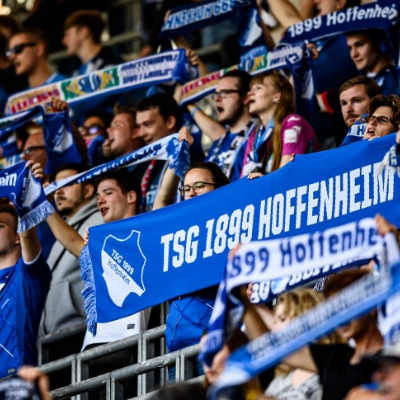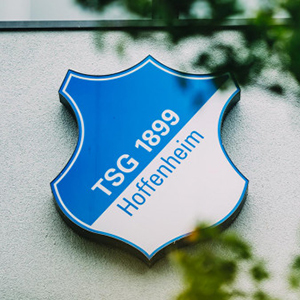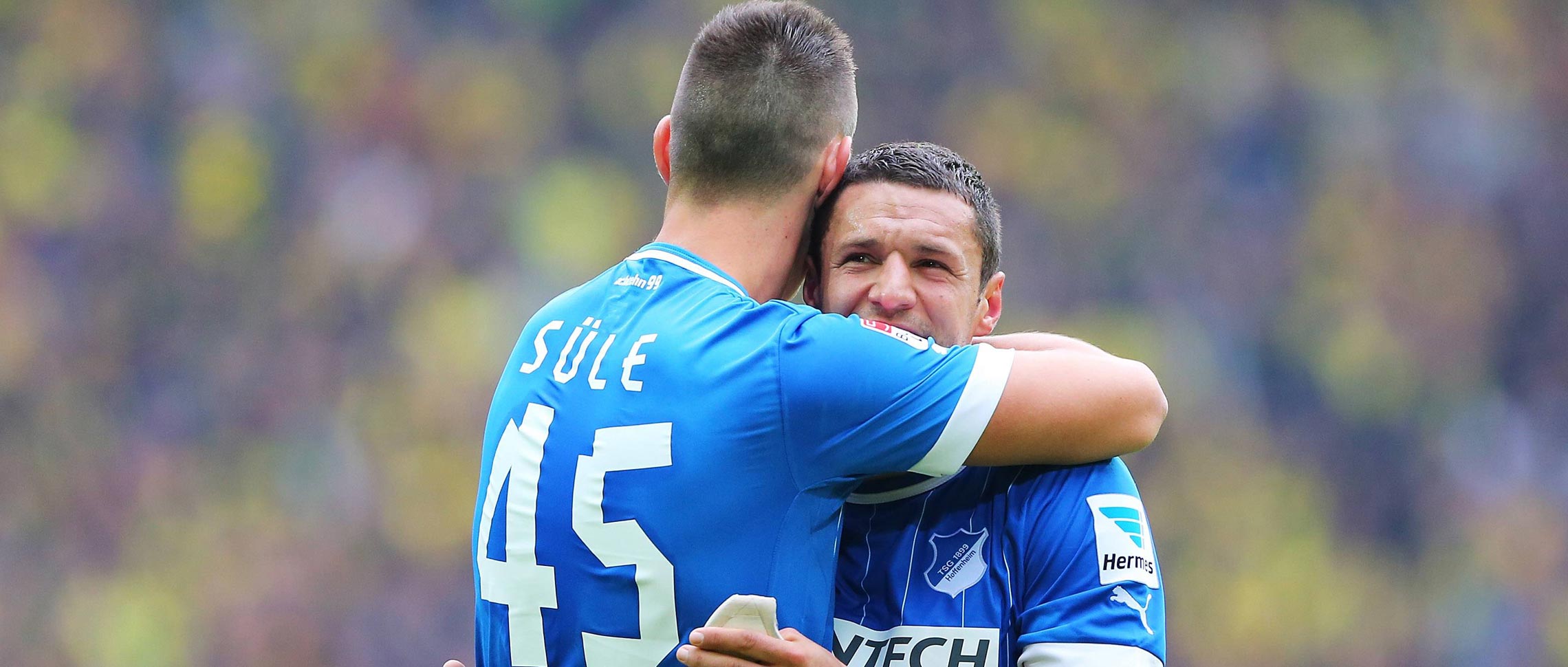Much more than just numbers
11 May 2013 will live long in the memory for Niklas Süle. Then only 17 years old, the central defender became the youngest player in TSG's history when he made his Bundesliga debut that day. But what stayed with Süle more than the 4-1 defeat to Hamburger SV was the number that was emblazoned across the back of his shirt that afternoon: the number 45. Fast forward seven and a half years, and Süle's record as Hoffenheim's youngest-ever player has since been beaten by Maximilian Beier. But there is still one record from that game that remains until this day: never before or since has a Hoffenheim player made a Bundesliga appearance with a higher shirt number than the now 25-year-old Germany defender did during his time in the Kraichgau.
The number has a special meaning not only for the club, but for Süle too. The memories of that first taste of top-flight football with TSG Hoffenheim prompted the player to rename the bar which he has recently opened in Mörfelden-Walldorf with his brother Fabian after his debut shirt number. "Forty Five" is printed in big letters above the entrance of the bar, which used to be called "Peoples". "Things really got going for me at TSG while I had that number. When I was playing with it, Fabian went to America. He was there for four years. We mostly only talked via Facetime. And when he came home at Christmas time, we'd always meet in "Peoples", talk for hours and enjoy the fact we could finally meet in person again. 'Peoples' became more and more important for us. Hence the name."
Many other footballers have special memories of or emotional connections to their numbers. Andreas Görlitz, the division's shirt number "record-holder", chose to wear the number 77 after moving from Munich to KSC in summer 2007 – because he was the frontman of the rock band "Room 77". Then there was Bixente Lizerazu, who proudly wore the number 69 for Bayern Munich – for several reasons: he was born in 1969, was 1.69m tall and weighed 69 kilos. But in 2011, the DFL changed the rules and banned all numbers above 40. Nowadays, shirt numbers up to 49 are allowed. That said, there had been some exceptions beforehand too: for example, if a team had more than 40 registered players or if a player had a higher shirt number before the rule change came into force.
Though it may sound inconceivable in the modern era when you consider their usefulness and marketing potential, permanently assigned shirt numbers were by no means part and parcel of football in the early days. The current trend of players using their shirt numbers to create independent brands – Cristiano Ronaldo is the most prominent example with his CR7 collection – only began in the Bundesliga 33 years after its inception. This is considerably later than in American sport, for example, where fixed numbers from 0 to 99 have long since been the norm. In German professional football, it was not until 11 August 1995 that players in the Bundesliga took to the field with fixed shirt numbers for the first time. From this point onwards, the player names were printed on the back of kits, making fixed shirt numbers unavoidable.
Origin of the numbers
When numbers first appeared on the back of football shirts is not clear and is still a topic of discussion for sports historians. Some sources name two games that took place in England on 25 August 1928 – Arsenal against Sheffield Wednesday and Chelsea versus Swansea – as the first time shirt numbers were used in football. But the 1933 FA Cup final, which pitted Everton against Manchester City, is also frequently cited. Another theory – albeit one that is disregarded in England – is that shirt numbers first made their debut in Australia in 1911. Legend has it that players wore numbers more than 100 years ago for the Sydney derby between Leichhardt and HMS Powerful. However, there is widespread agreement that shirt numbers became compulsory in international matches in 1939.
It was not until nine years later that supporters in Germany enjoyed the benefit of being able to identify players by means of their shirt numbers. Numbers were printed on the back of jerseys in the top flight in the 1948/49 season – though this did not apply to every club: 1. FC Nuremberg did not think much of the numbers idea and probably took secret delight in the fact that opposing players could not easily identify their players until 1951. As no substitutions were allowed in those days and there was obviously no self-promotion on social networks, the numbers were always between 1 and 11. And the players didn't even get to choose from that range; instead, they were allocated a number based on their respective positions.
The legendary 'Scottish inverted pyramid' formation – nowadays a strange-sounding and highly attacking 2-3-5 system from the early years – played a determining role in the allocation of shirt numbers. The goalkeeper was given the number 1, with the remaining numbers allocated from bottom to top and right to left. Tactics quickly changed however, and many countries developed their own individual systems of play, which meant that numbers acquired different meanings in different parts of the world. But what has remained the case worldwide from those days is that defenders tend to have lower and attackers higher numbers within the classic 1-11 range. The first shift came following the 1925 change to the offside rule (a player was now deemed offside if there were fewer than two defenders between the attacker and the goal), which prompted then Arsenal coach Herbert Chapman to move a midfielder into the centre of defence and the two defenders slightly wider – and thus the "WM" system was born. Five became the libero's number, 2 and 3 belonged to the full-backs, and for decades in Europe the central player in front of the defence wore the number 4 and was seen as a real hardman. Perhaps there is no better example of this than the Englishman Vinnie Jones, nicknamed "The Axe".
But there were fewer changes further up the pitch. Ten remained allocated to the playmakers and creative geniuses, while 9 was for the central strikers. To this day, 7 and 11 still tend to be worn by wide forwards. But there are also deviations and novelties in attacking positions too, as illustrated by the term "false nine". This refers to a player who plays up front but is actually at home in midfield. The number on the shirt remains the same whether the player is a "false" or a "genuine" nine. In addition, it tends to stand out when a striker plays with a lower shirt number. One such example is former Hoffenheim striker Sandro Wagner, who lined up for Bayern Munich wearing the shirt number 2 because it was his "second spell in Munich".
Numbers games at the World Cup
At the major international tournaments, the old associations between numbers and positions still retain their significance and are more noticeable. Since international federations like FIFA and UEFA only allow consecutive numbers up to 23 at World Cups and European Championships, classic numbers carry greater value at the world's biggest football tournaments. On the one hand, because personally chosen numbers worn at club level are not available for selection if above 23; and on the other hand, because it is often seen as a special honour to wear the numbers of former heroes and legends on the national jersey. Some of them, however, had nothing to do with the choice of their number, with some national coaches simply distributing the numbers to outfield players alphabetically. This was the case for the Dutch at the 1974 World Cup, for example – which resulted in goalkeeper Jan Jongbloed wearing 8 on his back. Oh, and yes, "King Johan" Cruyff was still allowed to keep his beloved "14" – just as the young Diego Maradona was allowed to keep the Argentina No. 10 eight years later. Otherwise, however, the South Americans also adopted the alphabetic approach and gave midfielder Osvaldo Ardiles the No. 1. Regardless of their reasoning, many players in football history remain closely associated with numbers as well as positions.





















